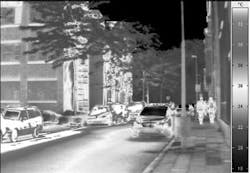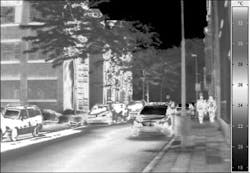Fraunhofer researchers develop uncooled LWIR sensor for low-cost applications
Research scientists at the Fraunhofer Institute for Microelectronic Circuits and Systems IMS (Duisburg, Germany) have produced an imaging sensor for the long-wave infrared (LWIR) range that functions at room temperature. "We could be the first in Germany to offer this technology," says Dirk Weiler, scientist at the IMS.
At the heart of the IRFPA (infrared focal plane array) sensor is a microbolometer – a temperature-sensitive detector that absorbs long-wave infrared light. To produce a two-dimensional image, several microbolometers are combined to form an array. If the microbolometer absorbs light from a heat source, its interior temperature rises and its electrical resistance changes.
A readout chip then converts this resistance value directly into a digital signal. Previously this was not possible without a further intermediate step – normally the electrical pulse is first translated into an analog signal and then digitized using an analog/digital converter. "We use a very specific type of converter, a sigma-delta converter, in our imager. This has enabled us to produce a digital signal directly," Weiler explains.
The IMS sees night driving as a prime application for this sensor. The problem has been that IR cameras for the wavelength range above 5 microns must be constantly cooled down to about -193 C. Uncooled imagers for the long-wave infrared range exist today, but are mainly used in the military and are more or less unavailable on the European market. As complex and costly cooling is no longer required, further areas of application become feasible beyond the automotive sector.
"Mobile devices in particular should benefit from the new development," states Weiler confidently. The fact that the cooling mechanism is no longer needed not only saves weight. The battery power available and therefore the operating time of the mobile device increase because no energy is needed for cooling. The potential uses of mobile IR cameras include firefighting, where they could detect hidden hotspots or locate people in smoke-filled buildings.
Initial laboratory tests with the new sensor element were successful. The research scientists have already been able to produce a number of infrared images.
For more information about research at Fraunhofer IMS, click HERE.
Posted by Vision Systems Design

